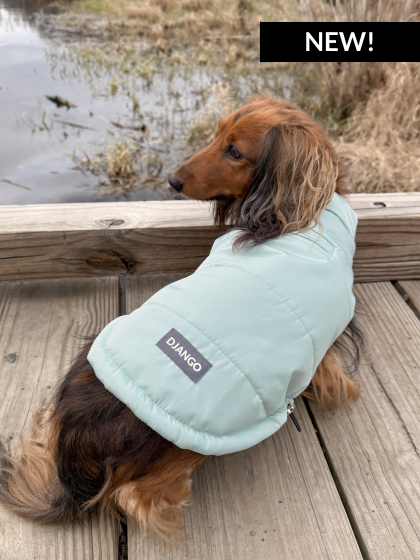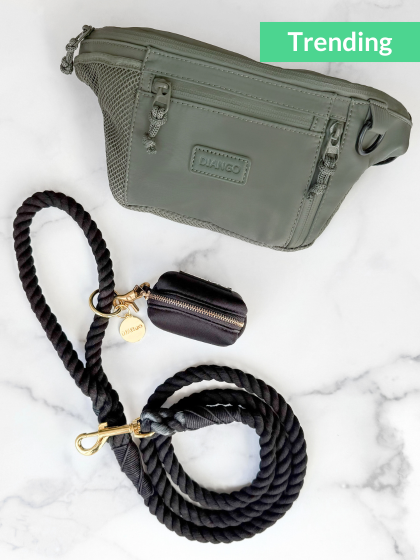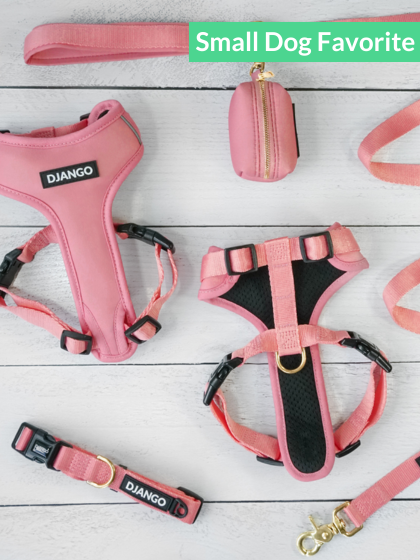Our dachshund Django is obsessed with swimming, and he absolutely loves the beach. He screams with joy like an elderly lady who just won the lottery whenever he sees the ocean.
Django's long and low-riding frame makes him very susceptible to picking up debris and insects when we're out adventuring. After he picked up fleas during a family beach vacation to North Carolina a few years back, Mike and I (Steph) went into hardcore research mode to learn more about flea risks at the beach.
Can dogs get fleas from the beach? Are fleas common in sand? What are sand fleas, and where do they come from? How are they different from regular fleas? Here is everything you need to know.
Sand fleas vs. regular fleas
There are two types of fleas. The first type of flea, the household name for order Siphonaptera, is the most well-known creature. This one is the flightless insect that jumps onto your dog, particularly in warmer months, bites and feeds off of him or her, and ultimately lays eggs. These are the fleas that will cause itching, scratching, and a home infestation if not addressed immediately.
Regular fleas are commonly found in grassy, wooded, and sandy areas. They thrive in shady and damp areas and are often unwelcome creatures on pets and in backyards.
Are these fleas found at the beach? Not usually. Although flea larvae can thrive in damp sand and soil, adult fleas won't be found in dry, hot, and sun-soaked sand.
What are sand fleas?
The other type of flea is called the sand flea. Sand fleas are not actually fleas but parasitic crustaceans. They are often found in warm, tropical regions including the very southern United States.
Sand fleas jump, similar to the way fleas do, and are also known as beach fleas, sand hoppers, and beach hoppers.
Sand fleas are very small and range from 0.25 to 1 inch in length, depending on the species. One species of sand flea found in the northeast Atlantic and Mediterranian, Talitrus saltator, grows to 0.65 inches in length. Sand fleas are a grayish-brown or grayish-green color, helping them blend into the sand. They have two noticable black eyes, 10 legs, and a pair of antenae.
Where exactly do sand fleas live?
While sand fleas are very common in the West Indies and South and Central America, they can also be found in marches, along the coastal United States, and even on the Mediterranean coast. Florida's eastern and Gulf coasts, North Carolina's banks, and even Southern California beaches are known to have sand flea colonies.
Sand fleas live and burrow in... you guessed it... the sand. Sand flea colonies are most commonly found in the slushy foreshore, the area of the beach that stays consistently wet due to tide and wave flows. The critters generally stay hidden during the hot, sunny hours of the day and come out in the cooler early morning and evening hours to forage on washed up kelp, seaweed, and animal matter. They are also more active on the beach immediately after it rains and when there is still cloud cover.
Are sand fleas dangerous?
Yes and no. In certain parts of the world, some sand flea species are known to aggressively bite and burrow into human and animal skin. Since sand fleas are not technically insects but crustaceans, over-the-counter flea and tick preventatives are not effective treatments for these sand flea bites. Biting and burrowing sand fleas can actually cause more harm to people and dogs than regular dog and cat fleas. Left untreated, a sand flea infection can lead to severe discomfort, anemia, and even liver damage.
If you live in the United States, we have good news for you. Biting and burrowing sand fleas - the species that are most likely to attack human and animal flesh and dig into the skin - are fortunately not a threat in the United States. The sand fleas found in US coastal regions are typically scared of humans and much more interested in feeding on washed-up seaweed and decaying animal matter - rather than you or your dog. Given their non-threatening nature, US-based sand fleas are actually quite popular among fisherman as high quality bait.
What are the symptoms and treatment of sand flea bites?
Symptoms of sand flea bites include mosquito-like bites, black spots in the middle of the swollen areas (these may be breeding sand fleas), fever and relentless scratching.
Veterinarians must remove sand fleas directly from under your pup’s skin. Most likely, your vet will recommend cleaning the treated skin with alcohol or another disinfectant to prevent infection.
5 ways to prevent sand flea bites on you and your dog
1. Avoid the beach after it rains. Avoid visiting the beach immediately after a rainfall. Sand fleas prefer cool air and cloud cover and are particularly aggressive when the air cools down after it rains.
2. Go to the beach mid-day. Sand fleas are more active in the early morning and evening when the sun is not burning hot and high in the sky.
3. Bring a towel or beach mat. Creating a simple barrier between you and the sand will minimize the risk of being bitten. Sit or lay on a large beach towel, mat or bedsheet so your feet, ankles and limbs aren't resting in the sand.
4. Don't dig. Sand fleas commonly attack feet, ankles and calves since these are easy targets. Avoid burying your feet in the sand, and prevent your pup from digging and burrowing.
5. Shower after leaving the beach. Rinse off right after leaving the beach (your dog included) and shake out your beach towels to reduce the risk of transporting sand fleas into your car or home.
Additional resources
DJANGO's Adventure Dog Harnesses and Leashes are designed for rugged adventures and everyday use. The Adventure Dog Harness features a weather-resistant and padded neoprene exterior with reflective piping, breathable sport mesh lining, supple and colorfast webbing, and four points of adjustment for a custom fit. The Adventure Dog Leash features heavy-duty and colorfast webbing, an ultra-padded neoprene handle for max comfort, and a functional D-ring. Solid cast brass hardware adds additional strength, durability, and sophistication to the adventure-ready designs.















2 comments
DJANGO
@DEBI Hello and thanks for reaching out! Since sand fleas are not insects but crustaceans, over-the-counter flea and tick preventatives are not effective. I’m not sure where you are located, but generally speaking sand fleas are not a huge concern for dog owners in the United States. Although they might be prevalent at certain beaches (which largely depends on geography), the likelihood of a sand flea burrowing under your dog’s skin after a short beach visit is slim. Also, unlike standard ‘house fleas’ which we dog owners are most aware of (i.e. the insects that can proliferate on a dog’s body and ultimately infect a house ), sand fleas will not travel home with you or your dog and spread throughout your home.
If you are concerned about sand fleas, I advise contacting the local sheriff and/or tourism office in the beach town that you are visiting. Ask them if their beaches are known for sand fleas. If yes, I’d then reach out directly to your vet to see what topical ointments (if any) are best for sand flea bite treatment. We at DJANGO are not medical professionals, so we’d never advise you to use a certain medicine or topical ointment for your pup. These matters are best addressed by a licenced veterinarian.
Hope this helps! Hope you and your pup have a wonderful summer.
@DEBI Hello and thanks for reaching out! Since sand fleas are not insects but crustaceans, over-the-counter flea and tick preventatives are not effective. I’m not sure where you are located, but generally speaking sand fleas are not a huge concern for dog owners in the United States. Although they might be prevalent at certain beaches (which largely depends on geography), the likelihood of a sand flea burrowing under your dog’s skin after a short beach visit is slim. Also, unlike standard ‘house fleas’ which we dog owners are most aware of (i.e. the insects that can proliferate on a dog’s body and ultimately infect a house ), sand fleas will not travel home with you or your dog and spread throughout your home.
If you are concerned about sand fleas, I advise contacting the local sheriff and/or tourism office in the beach town that you are visiting. Ask them if their beaches are known for sand fleas. If yes, I’d then reach out directly to your vet to see what topical ointments (if any) are best for sand flea bite treatment. We at DJANGO are not medical professionals, so we’d never advise you to use a certain medicine or topical ointment for your pup. These matters are best addressed by a licenced veterinarian.
Hope this helps! Hope you and your pup have a wonderful summer.
Debi
I’m going to the beach and wanted to take my dog, but I’m super worried about sand fleas. Your article says to rinse yourself and your pet after being in the sand. Would any kind of flea shampoo be best to use. My dog already has taken a flea & tick med. from when we went camping. I don’t want to mix to many flea products.
I’m going to the beach and wanted to take my dog, but I’m super worried about sand fleas. Your article says to rinse yourself and your pet after being in the sand. Would any kind of flea shampoo be best to use. My dog already has taken a flea & tick med. from when we went camping. I don’t want to mix to many flea products.